Research on the Stability of Salt Cavern Hydrogen Storage and Natural Gas Storage under Long-Term Storage Conditions
Abstract
1. Introduction
2. Damage Constitutive Model of Salt Cavern Gas Storage Due to Thermal Stress
2.1. Model Assumptions
- (1)
- Both the salt layers and interlayers are isotropic homogeneous media.
- (2)
- The temperature and density of hydrogen are solely dependent on time.
- (3)
- Hydrogen adheres to the ideal gas law, and its flow conforms to Darcy’s law.
- (4)
- Before the hydrogen cycle of storage and release, the salt cavern contains hydrogen gas at a certain initial temperature and pressure.
2.2. Model Derivation
3. Numerical Simulation Computation
3.1. Engineering Background and Geometric Model
3.2. Parameter Configuration
3.3. Software Settings and Boundary Conditions
3.4. Uncertainty Evaluation
4. Results and Discussion
4.1. Stability of Gas Storage in Salt Caverns under Constant Pressure
4.1.1. Effective Stress in Cavity
4.1.2. Cavity Displacement
4.1.3. Constant Pressure Rheology
4.1.4. Plastic Zone of the Surrounding Rock
5. Conclusions
- (1)
- By placing greater emphasis on the enhanced thermal effects during the hydrogen cyclic storage and release process, the equations for stress equilibrium and constitutive relations are derived.
- (2)
- At the same storage pressure, the effective stress at the same position in the interlayer is greater for hydrogen storage compared to natural gas storage, signifying a higher level of danger.
- (3)
- At the same storage pressure, the displacement at the cavity top for hydrogen storage is greater than that for natural gas storage. The displacement difference between the two is greatest at 9 MPa, amounting to 0.026 m.
- (4)
- Due to hydrogen’s lower dynamic viscosity and higher permeability, the depth and extent of the plastic zones within the interlayers are greater compared to natural gas.
Author Contributions
Funding
Data Availability Statement
Conflicts of Interest
References
- Zhu, S.; Shi, X.; Yang, C.; Li, Y.; Li, H.; Yang, K.; Liu, X. Hydrogen loss of salt cavern hydrogen storage. Renew. Energy 2023, 218, 119267. [Google Scholar] [CrossRef]
- Indro, A.P.; Okoroafor, E.R. Analytical equations to estimate hydrogen storage efficiency factor and storage capacity in saline aquifers. J. Energy Storage 2024, 92, 112228. [Google Scholar] [CrossRef]
- Sainz-Garcia, A.; Abarca, E.; Rubi, V.; Grandia, F. Assessment of feasible strategies for seasonal underground hydrogen storage in a saline aquifer. Int. J. Hydrogen Energy 2017, 42, 16657–16666. [Google Scholar] [CrossRef]
- Gajda, D.; Lutynski, M. Hydrogen Permeability of Epoxy Composites as Liners in Lined Rock Caverns-Experimental Study. Appl. Sci. 2021, 11, 3885. [Google Scholar] [CrossRef]
- Thiyagarajan, S.R.; Emadi, H.; Hussain, A.; Patange, P.; Watson, M. A comprehensive review of the mechanisms and efficiency of underground hydrogen storage. J. Energy Storage 2022, 51, 104490. [Google Scholar] [CrossRef]
- Tarkowski, R.; Uliasz-Misiak, B. Towards underground hydrogen storage: A review of barriers. Renew. Sustain. Energy Rev. 2022, 162, 112451. [Google Scholar] [CrossRef]
- Muhammed, N.S.; Haq, B.; Al Shehri, D.; Al-Ahmed, A.; Rahman, M.M.; Zaman, E. A review on underground hydrogen storage: Insight into geological sites, influencing factors and future outlook. Energy Rep. 2022, 8, 461–499. [Google Scholar] [CrossRef]
- Tarkowski, R. Underground hydrogen storage: Characteristics and prospects. Renew. Sustain. Energy Rev. 2019, 105, 86–94. [Google Scholar] [CrossRef]
- Li, Q.; Wang, Y.L.; Wang, Y.J.; San, J.; Li, Q.; Foster, G. Synthetic process on hydroxyl-containing polydimethylsiloxane as a thickener in CO2 fracturing and thickening performance test. Energy Sources Part A. Recovery Util. Environ. Eff. 2018, 40, 1137–1143. [Google Scholar] [CrossRef]
- Abuaisha, M.; Rouabhi, A.; Billiotte, J.; Hadj-Hassen, F. Non-isothermal two-phase hydrogen transport in rock salt during cycling in underground caverns. Int. J. Hydrogen Energy 2021, 46, 6632–6647. [Google Scholar] [CrossRef]
- Yang, C.; Jing, W.; Daemen, J.J.K.; Zhang, G.; Du, C. Analysis of major risks associated with hydrocarbon storage caverns in bedded salt rock. Reliab. Eng. Syst. Saf. 2013, 113, 94–111. [Google Scholar] [CrossRef]
- Zhu, S.; Shi, X.; Yang, C.; Bai, W.; Wei, X.; Yang, K.; Li, P.; Li, H.; Li, Y.; Wang, G. Site selection evaluation for salt cavern hydrogen storage in China. Renew. Energy 2024, 224, 120143. [Google Scholar] [CrossRef]
- Guo, Y.; Lan, X.; Cao, J.; Xu, B.; Xia, Y.; Yin, J.; Liu, Z. A comparative study of the reversible hydrogen storage behavior in several metal decorated graphyne. Int. J. Hydrogen Energy 2013, 38, 3987–3993. [Google Scholar] [CrossRef]
- Shi, X.; Liu, W.; Chen, J.; Yang, C.; Li, Y.; Ma, H.; Peng, H.; Wang, T.; Ma, X. Geological Feasibility of Underground Oil Storage in Jintan Salt Mine of China. Adv. Mater. Sci. Eng. 2017, 2017, 3159152. [Google Scholar] [CrossRef]
- Zhang, X.; Liu, W.; Jiang, D.; Qiao, W.; Liu, E.; Zhang, N.; Fan, J. Investigation on the influences of interlayer contents on stability and usability of energy storage caverns in bedded rock salt. Energy 2021, 231, 120968. [Google Scholar] [CrossRef]
- Zhang, N.; Yang, C.; Shi, X.; Wang, T.; Yin, H.; Daemen, J. Analysis of mechanical and permeability properties of mudstone interlayers around a strategic petroleum reserve cavern in bedded rock salt. Int. J. Rock Mech. Min. Sci. 2018, 112, 1–10. [Google Scholar] [CrossRef]
- Li, J.; Tang, Y.; Shi, X.; Xu, W.; Yang, C. Modeling the construction of energy storage salt caverns in bedded salt. Appl. Energy 2019, 255, 113866. [Google Scholar] [CrossRef]
- Liu, W.; Zhang, Z.; Chen, J.; Jiang, D.; Wu, F.; Fan, J.; Li, Y. Feasibility evaluation of large-scale underground hydrogen storage in bedded salt rocks of China: A case study in Jiangsu province. Energy 2020, 198, 117348. [Google Scholar] [CrossRef]
- Firme, P.A.L.P.; Quevedo, R.J.; Roehl, D.; Pereira, L.C.; Cazarin, C.L. Mechanical behavior of carbonate reservoirs with single karst cavities. Geomech. Energy Environ. 2021, 25, 100209. [Google Scholar] [CrossRef]
- Wang, T.; Yang, C.; Ma, H.; Daemen, J.; Wu, H. Safety evaluation of gas storage caverns located close to a tectonic fault. J. Nat. Gas Sci. Eng. 2015, 23, 281–293. [Google Scholar] [CrossRef]
- Wang, T.; Ding, Z.; He, T.; Xie, D.; Liao, Y.; Chen, J.; Zhu, K. Stability of the horizontal salt cavern used for different energy storage under varying geological conditions. J. Energy Storage 2024, 84, 110817. [Google Scholar] [CrossRef]
- Chen, S.; Zhang, Q.; Wang, G.; Zhu, L.; Li, Y. Investment strategy for underground gas storage facilities based on real option model considering gas market reform in China. Energy Econ. 2018, 70, 132–142. [Google Scholar] [CrossRef]
- Mahjour, S.K.; Badhan, J.H.; Faroughi, S.A. Uncertainty quantification in CO2 trapping mechanisms: A case study of PUNQ-S3 reservoir model using representative geological realizations and unsupervised machine learning. Energies 2024, 17, 1180. [Google Scholar] [CrossRef]
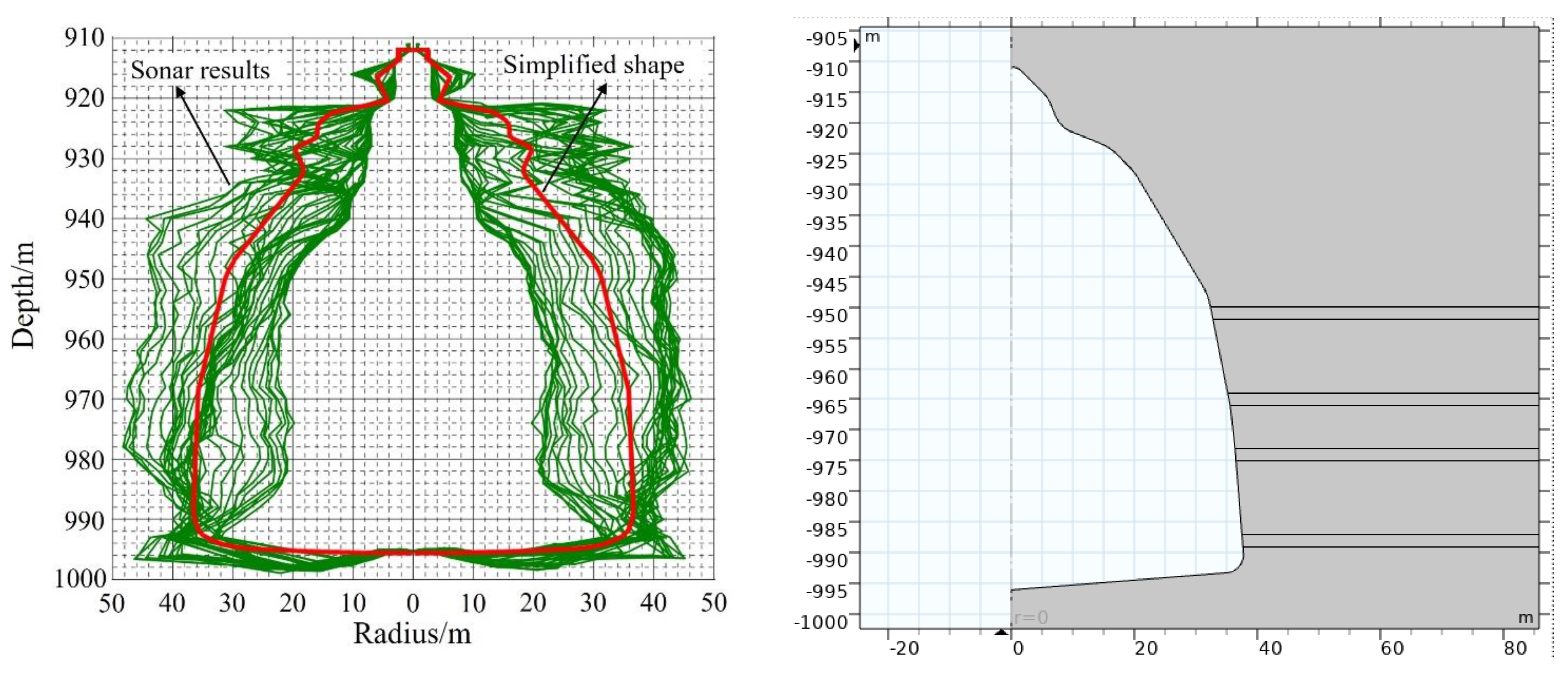
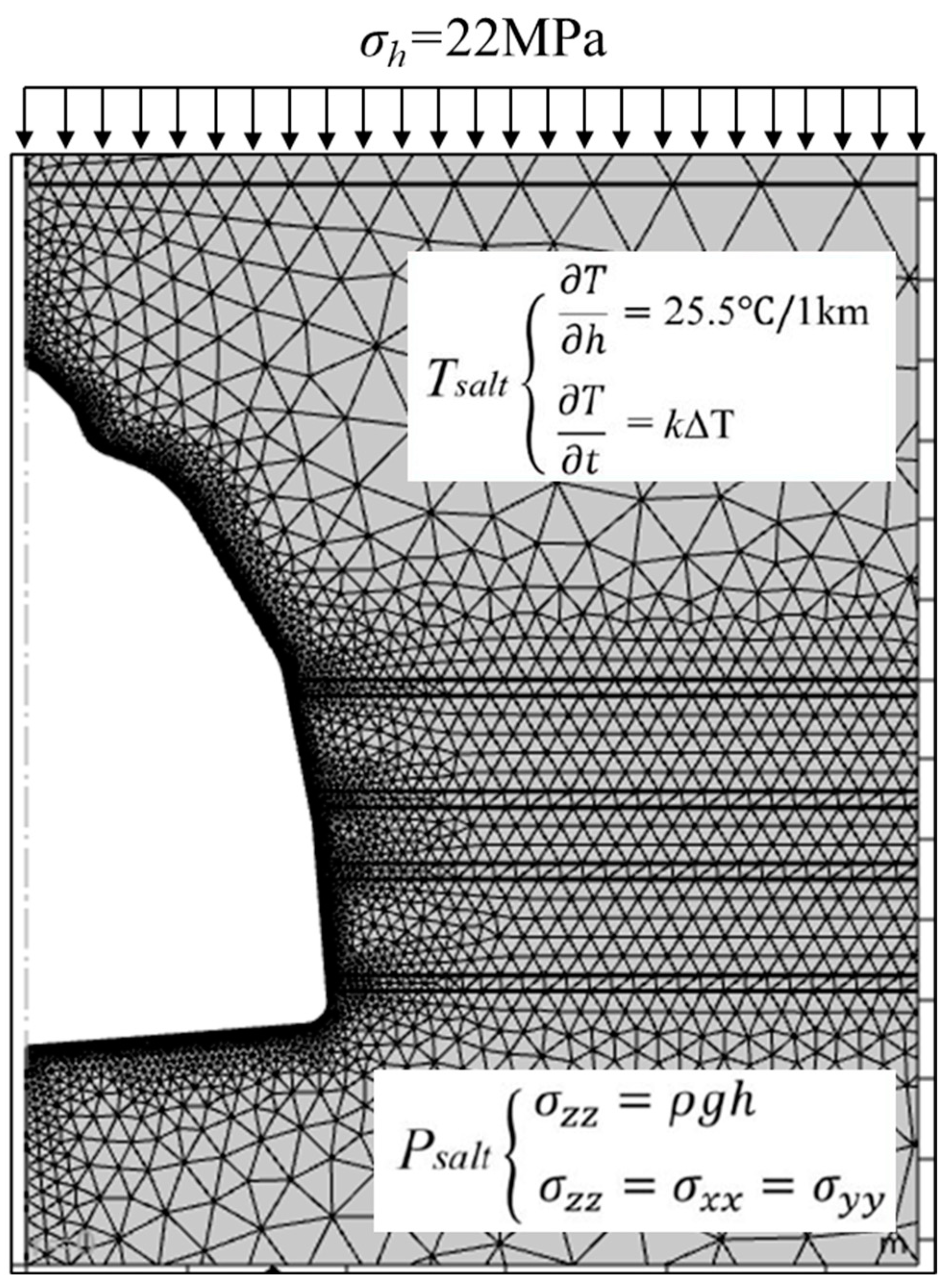
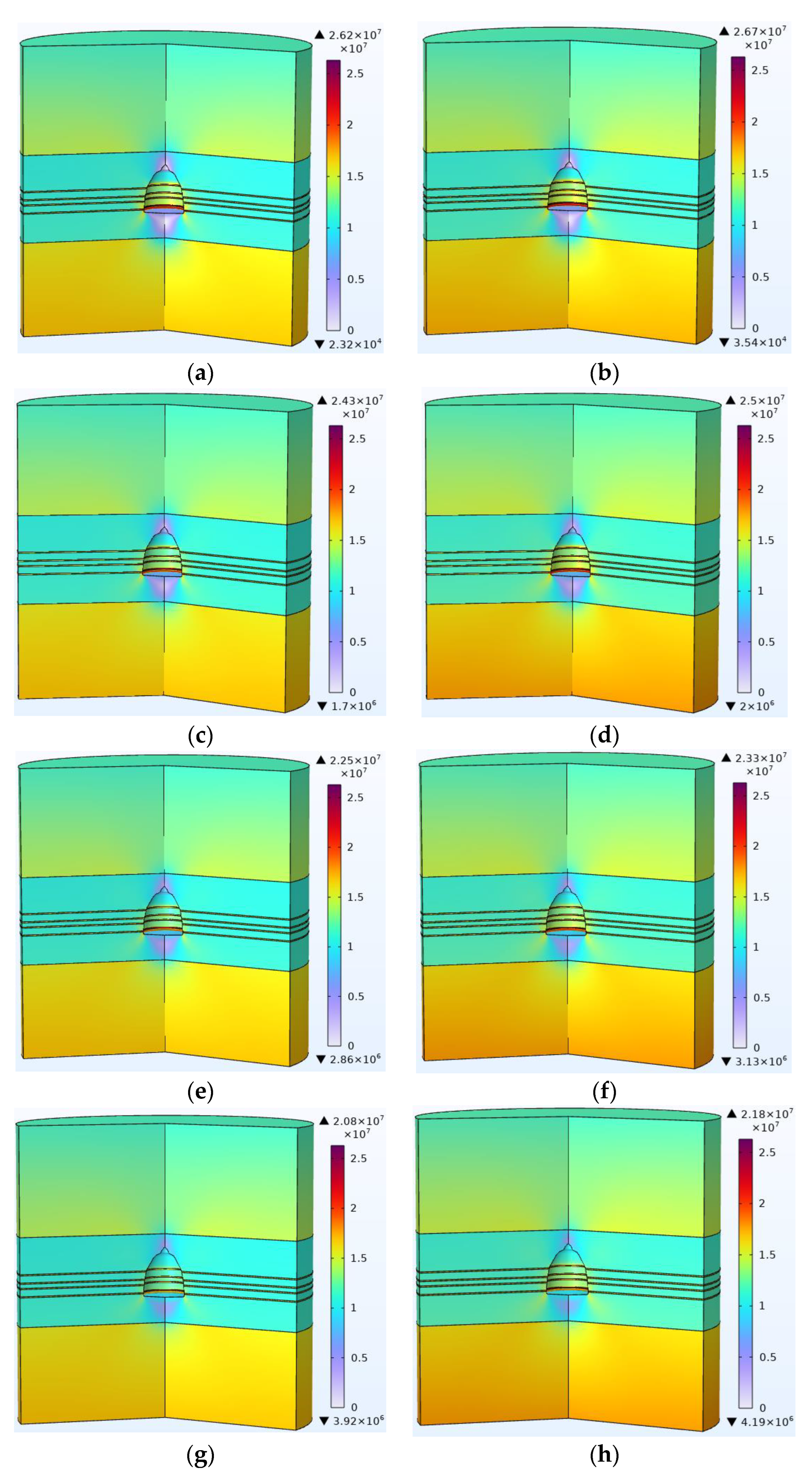
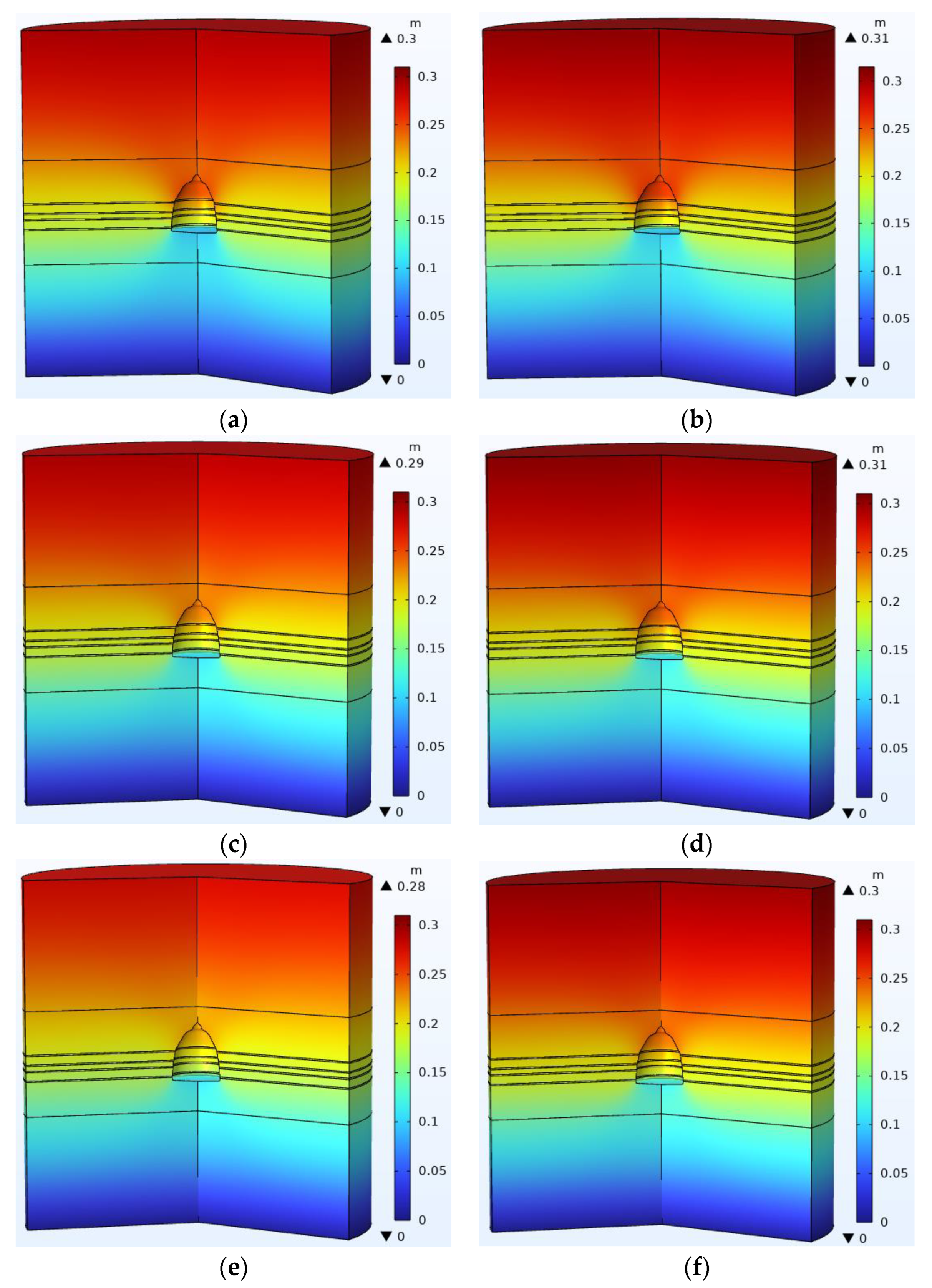

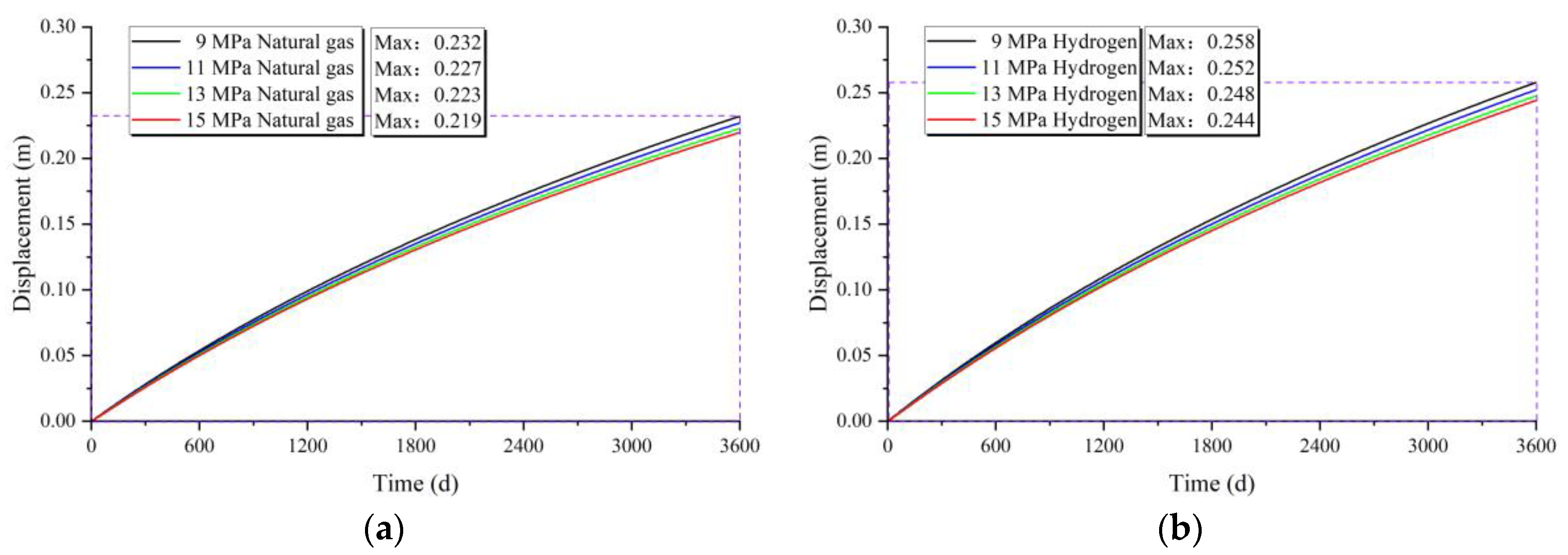
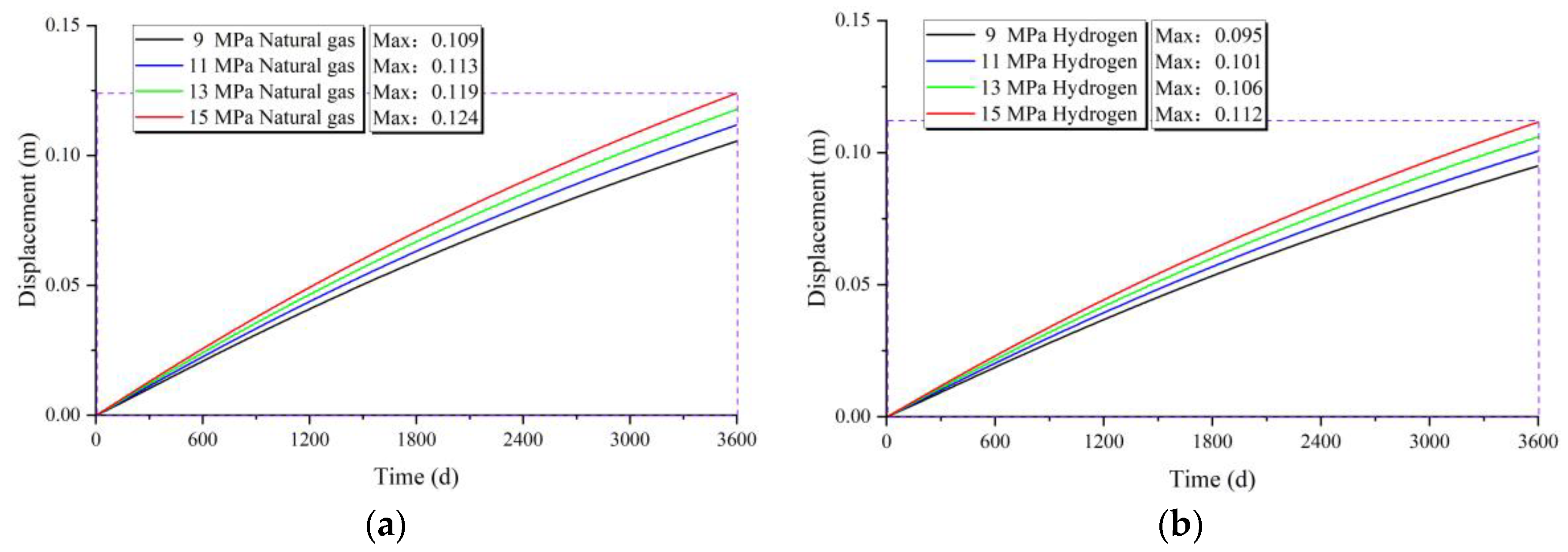
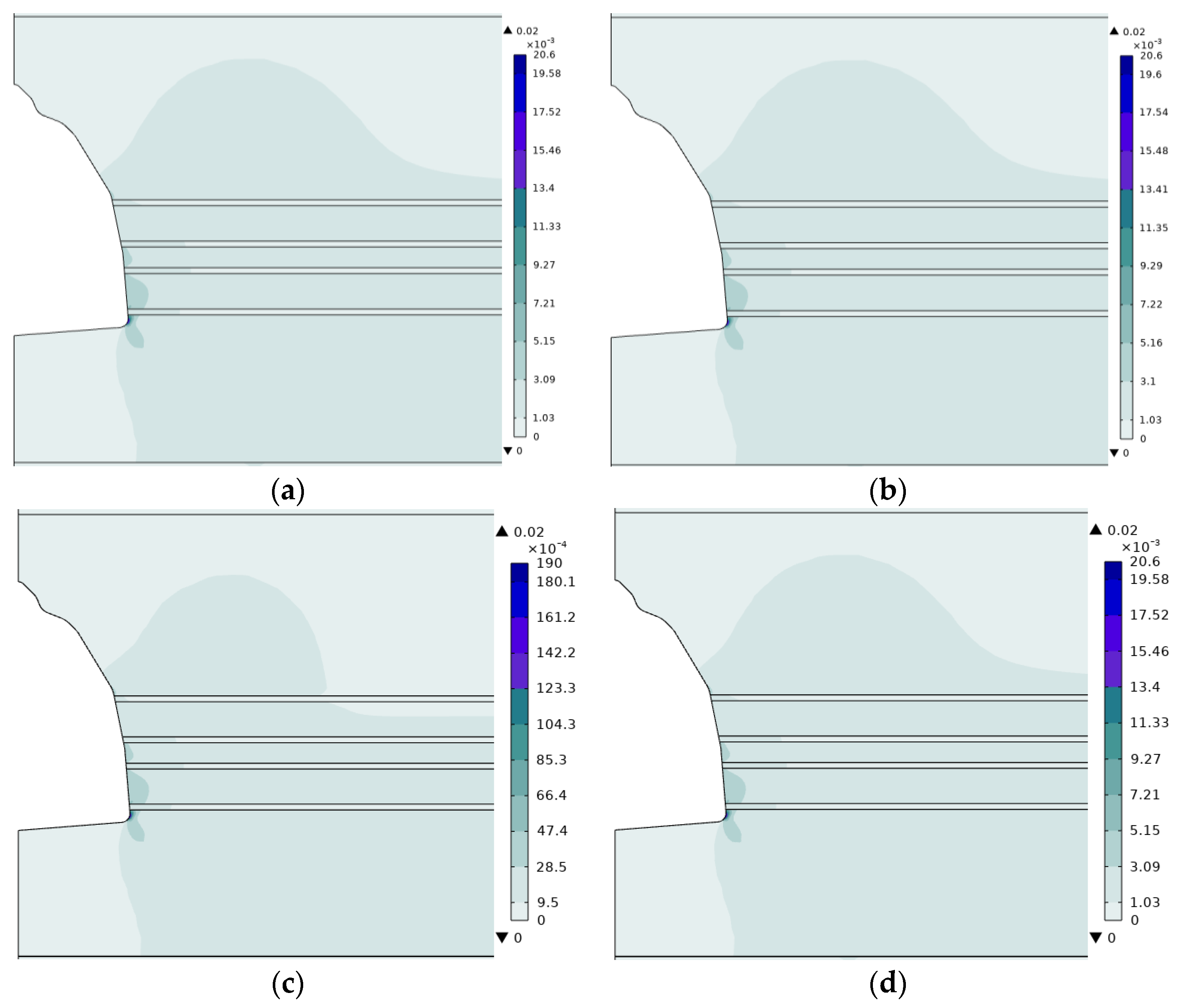
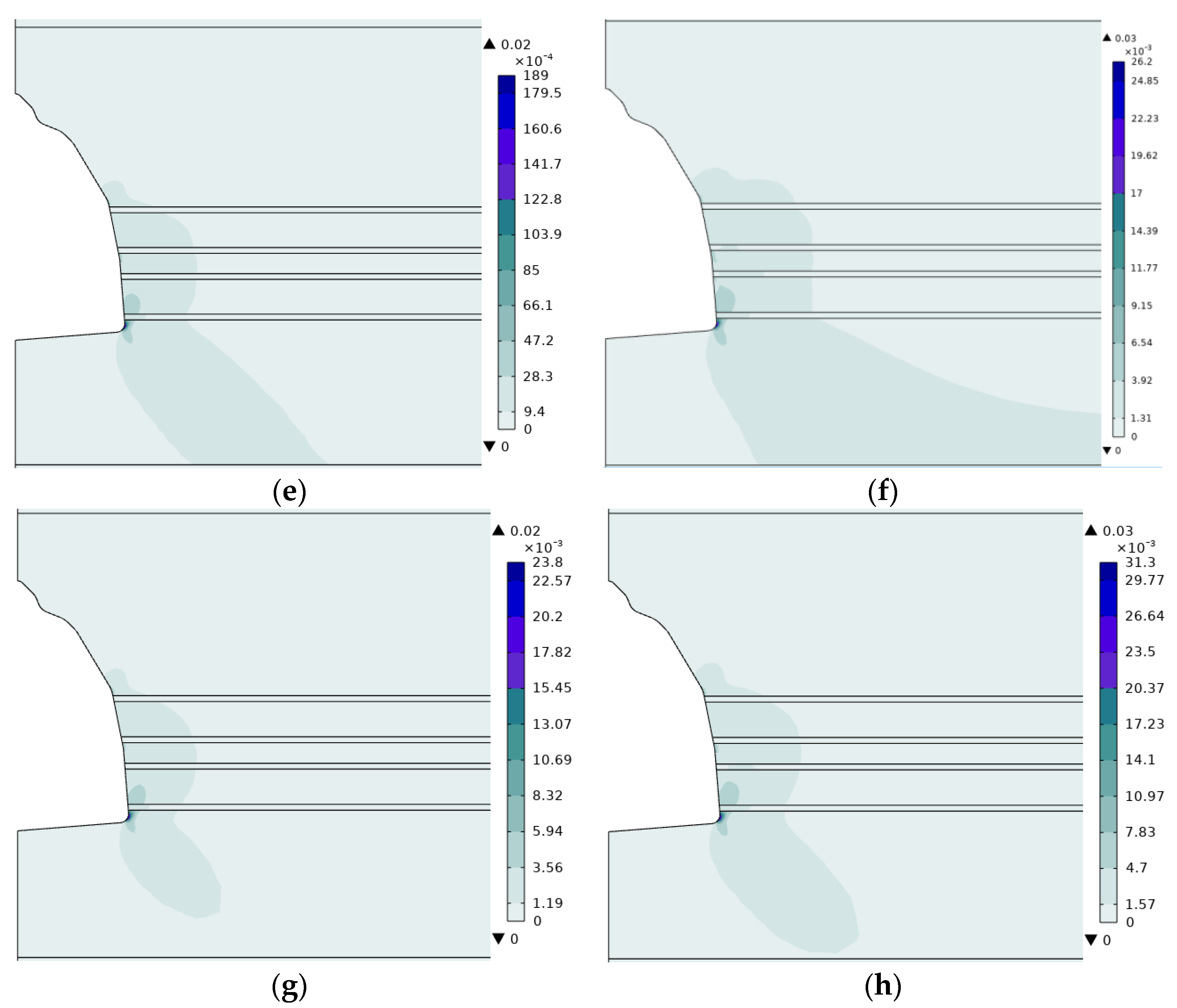


| Number | Parameters | Unit | Natural Gas | Hydrogen |
|---|---|---|---|---|
| 1 | Specific heat capacity | J/(kg·K) | 2215 | 14,300 |
| 2 | Thermal conductivity | 4500 | 0.1047 | 0.1805 |
| 3 | Molar mass | kg/mol | 0.016 | 0.002016 |
| 4 | Dynamic viscosity | Pa·s | 1.1 × 10−5 | 0.8915 × 10−5 |
| 5 | Gas state variable | J/(kg·K) | 519.63 | 4124 |
| Number | Parameters | Unit | Salt Rock | Mud |
|---|---|---|---|---|
| 1 | Porosity | 1 | 0.01 | 0.06 |
| 2 | Permeability | m2 | 1 × 10−20 | 1 × 10−18 |
Disclaimer/Publisher’s Note: The statements, opinions and data contained in all publications are solely those of the individual author(s) and contributor(s) and not of MDPI and/or the editor(s). MDPI and/or the editor(s) disclaim responsibility for any injury to people or property resulting from any ideas, methods, instructions or products referred to in the content. |
© 2024 by the authors. Licensee MDPI, Basel, Switzerland. This article is an open access article distributed under the terms and conditions of the Creative Commons Attribution (CC BY) license (https://creativecommons.org/licenses/by/4.0/).
Share and Cite
Liu, Z.; Liu, Y. Research on the Stability of Salt Cavern Hydrogen Storage and Natural Gas Storage under Long-Term Storage Conditions. Processes 2024, 12, 2080. https://doi.org/10.3390/pr12102080
Liu Z, Liu Y. Research on the Stability of Salt Cavern Hydrogen Storage and Natural Gas Storage under Long-Term Storage Conditions. Processes. 2024; 12(10):2080. https://doi.org/10.3390/pr12102080
Chicago/Turabian StyleLiu, Zhongzhong, and Yuxuan Liu. 2024. "Research on the Stability of Salt Cavern Hydrogen Storage and Natural Gas Storage under Long-Term Storage Conditions" Processes 12, no. 10: 2080. https://doi.org/10.3390/pr12102080
APA StyleLiu, Z., & Liu, Y. (2024). Research on the Stability of Salt Cavern Hydrogen Storage and Natural Gas Storage under Long-Term Storage Conditions. Processes, 12(10), 2080. https://doi.org/10.3390/pr12102080





